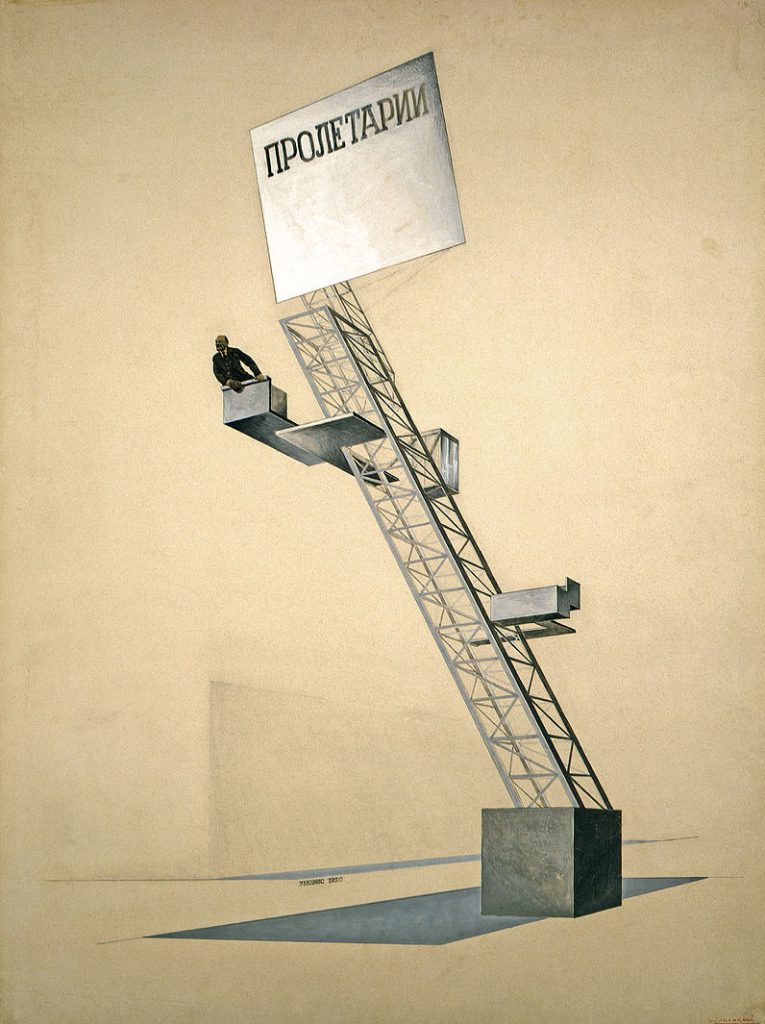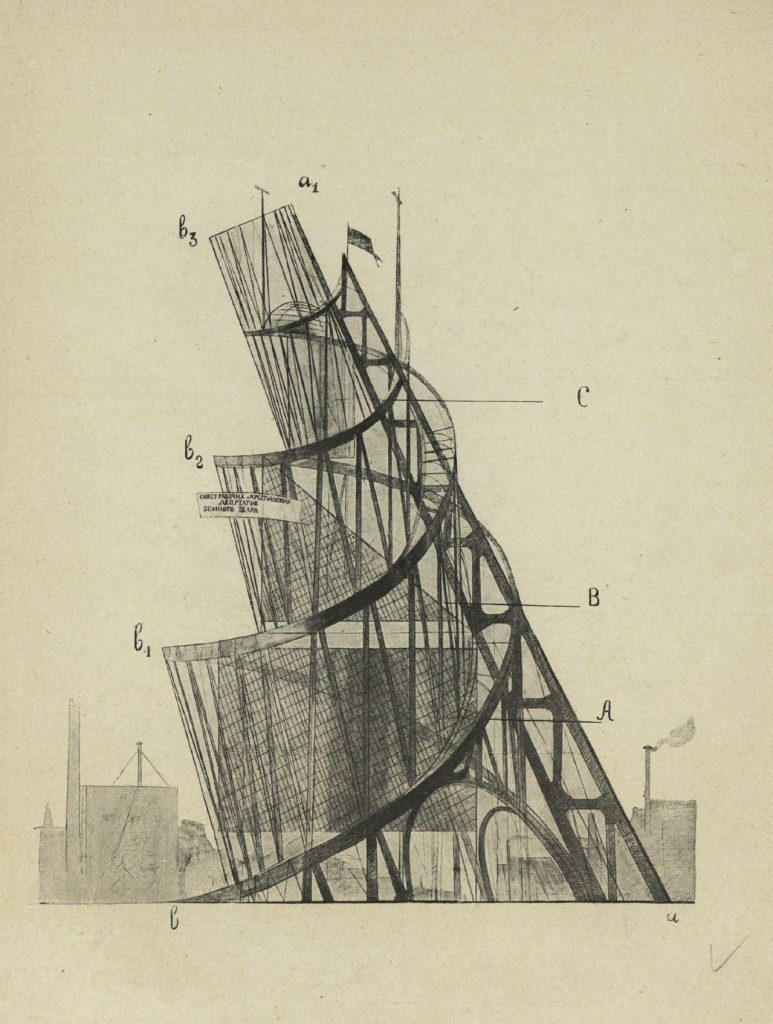Concrete, metal, and glass are cultural byproducts of modern architecture as a creature that modifies practically every object on the earth’s surface. Metal architecture is a form of inherited culture. Through experimentation on metal architecture in various eras, we have seen observable transitions between differing definitions of architectural ideology.
Text: Siriporn Dansakun

Photo Credit: Pawitra Pongpa
คาร์ลส มาร์ค กล่าวว่า มนุษย์สร้างประวัติศาสตร์และเรื่องราวของตนขึ้นเอง แต่อุบัติกาลเหล่านั้นร้อยเรียงกับสภาวการณ์และเงื่อนไขมากมาย ทั้งจากอดีตและปัจจุบัน แม้แต่วัฒนธรรมจากโลกที่ตายไปแล้วก็ยังคงส่งผ่านทางความคิดสู่โลกปัจจุบัน และเหล่าผู้คนแห่งปัจจุบัน ก็เป็นกลไกของวิวัฒนาการทางวัฒนธรรมที่จะสร้างสิ่งใหม่ต่อไปเรื่อยๆ
ในฐานะของสัตว์ที่แปรรูปวัตถุบนเปลือกโลกตลอดเวลา วัสดุที่เป็นผลลัพธ์ทางวัฒนธรรมของสถาปัตยกรรมสมัยใหม่ คือ คอนกรีต โลหะ และแก้ว โดยสถาปัตยกรรมโลหะ หรือ Metal Architecture นับเป็นผลลัพธ์หนึ่งที่เราส่งต่ออิทธิพลความคิดทางวัฒนธรรมกันมาเรื่อยๆ ซึ่งเราสามารถมองเห็นจังหวะเปลี่ยนผ่านของนิยามความคิดทางสถาปัตยกรรมผ่านการทดลองในงานสถาปัตยกรรมโลหะในช่วงยุคต่างๆได้อย่างชัดเจน
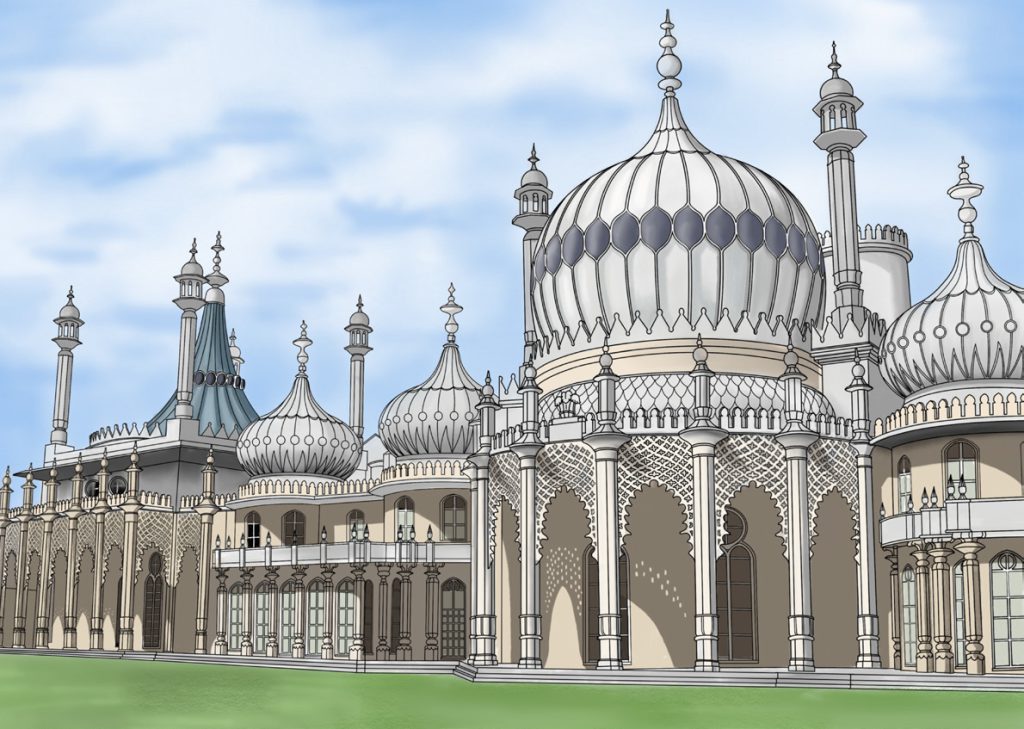
Photo Credit: Yospunya Pensuwan
นิยามคุณค่าของโลหะในเชิงสัจจะวัสดุ
เดิมทีโลหะถูกใช้เป็นองค์ประกอบที่ซ่อนเร้นหรือตกแต่ง แต่หนึ่งหมุดหมายทางประวัติศาสตร์ที่แสดงการยอมรับสัจจะวัสดุในสถาปัตยกรรมโลหะอย่างเป็นทางการคือการสร้างสถาปัตยกรรมโลหะในพื้นที่ของชนชั้นปกครอง เช่น Royal Pavilion โดย John Nash ใน Brighton ช่วงปี 1815–23 งานชิ้นนี้เผยสัจจะวัสดุของโลหะอย่างหมดจดทั้งเชิงโครงสร้าง พื้นผิวภายนอกและพื้นที่ภายใน สื่อสารศักยภาพของโลหะผ่านเสาที่บางเบา กับโครงสร้างอิสระที่ปรับตามภาษาทางสถาปัตยกรรมประเพณี ใช้เทคนิค maniera ของการล้อเลียนรูปฟอร์มเดิม โดยขึ้นรูปอย่างสถาปัตยกรรมอินเดีย แล้วนำโลหะมาแทนค่าวัสดุแบบ replacement เกิดเป็นสัญญะแห่งสถาปัตยกรรมในยุคอาณานิคมที่ประนีประนอมการรับรู้อย่างอดีต ด้วยเทคนิคก่อสร้างแบบใหม่
นิยามการทดลองเชิงศาสตร์และศิลป์
Sigfried Giedion มองว่าแต่เดิมนั้นสถาปัตยกรรมควบรวมกันระหว่างศิลปะและนวัตกรรม แต่เมื่อโลกยุคสมัยใหม่แยกศาสตร์เฉพาะทาง ก็ทำให้สถาปัตยกรรมแยกกันพัฒนาออกเป็นหลายฝั่ง และบางครั้งก็มีการขัดแย้งกันเอง ไม่ได้เป็นเนื้อหนึ่งเดียวอย่างแต่ก่อน สถาปัตยกรรมถูกแยกออกเป็นหลายศาสตร์ในยุคสมัยใหม่ โดยจะเห็นได้ชัดที่มีการก่อตั้งโรงเรียน École des Beaux-Arts ในปี 1648 และ École Polytechnique ปี 1794 ที่มีทิศทางแตกต่างกัน แต่ในความแยกศาสตร์ที่ชัดเจนนั้น ก็ยังคงมีคนที่พยายามยามจะรวมศาสตร์ทั้งสองเอาไว้ด้วยกันอย่างมีนัยยะสำคัญ
Henri Labrouste (1801-75) นักศึกษาสายศิลปะจาก École des Beaux-Arts École des Beaux-Arts เป็นคนช่างสงสัยเรื่องความหมายของศิลปะและขณะเดียวกันก็ศึกษานวัตกรรมอย่างจริงจังไปด้วย ผลงานออกแบบของเขา ซึ่งได้แก่ ห้องสมุด Bibliothèque Sainte-Geneviève (1843-50) และ Bibliothèque nationale de France (1858-68) จึงเป็นงานทดลองเชิงโครงสร้างโดยคนที่มีรากทางสถาปัตยกรรมเชิงศิลปะ
งานในยุคศตวรรษที่ 19 ของ Henri Labrouste เป็นตัวแทนของสถาปัตยกรรมสรรค์ผสาน (Eclecticism) ที่เล่าถึงจุดเชื่อมต่อทางการเปลี่ยนผ่าน การโต้แย้งและไกล่เกลี่ยกัน ระหว่างความเป็นศิลปะและนวัตกรรม ระหว่างความเก่าและความใหม่ ระหว่างต่อยอดและก้าวไปข้างหน้า ระหว่างประนีประนอมและเด็ดขาด โดยมีการแยกชั้นของสถานะวัตถุทางกายภาพ เชลเตอร์แห่งการปรับสภาพและควบคุมพลังงาน สถานะเครื่องกลแห่งวิถีชีวิต และสถานะวัตถุสาส์นแห่งการสื่อสาร กระจัดกระจายสัดส่วนกันไปตามพื้นที่ต่างๆ ที่มีความหมายต่างกันในตัวอาคารเดียว
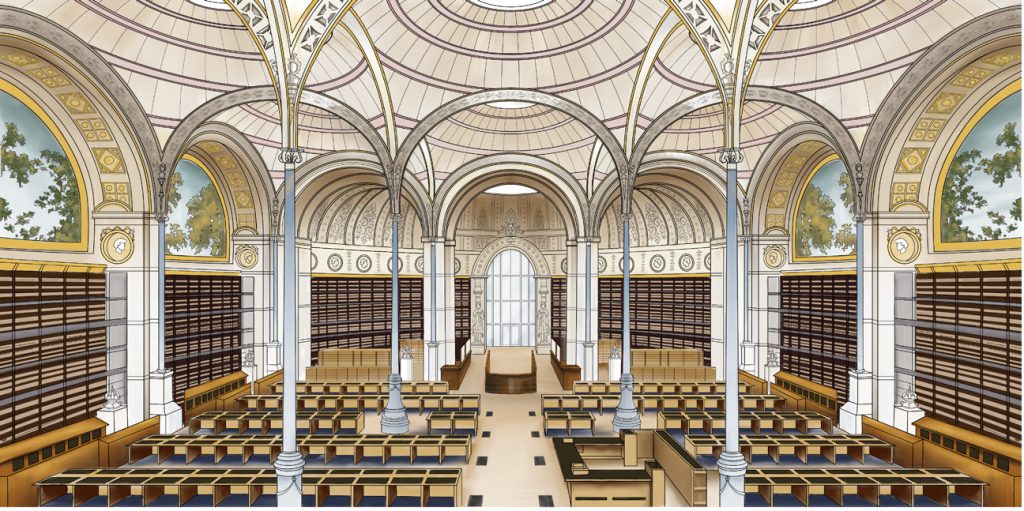
Photo Credit: Yospunya Pensuwan
นิยามความเป็นเครื่องกลแห่งวิถีชีวิตชนิดใหม่
สถาปัตยกรรมโลหะถูกพัฒนาต่อเนื่องมาเรื่อยๆ ตั้งแต่ศตวรรษที่ 19 และมีบทบาทในความเป็นการเมืองผ่านสถาปัตยกรรม การนำมาใช้แสดงออกถึงการแข่งขันทางนวัตกรรม และเป็นประเด็นสื่อสารเรื่องชนชั้นทางสังคม เมื่อมีการปฎิวัติทางอุตสาหกรรมและการเจริญเติบโตทางเทคโนโลยี นำพาไปสู่พัฒนาการทางเมืองอย่างรวดเร็ว เกิดวิถีชีวิตใหม่ สาธารณูปโภคแบบใหม่ อาชีพใหม่ การใช้เวลาแบบใหม่ และสถาปัตยกรรมสำหรับชีวิตแบบใหม่ก็เกิดอาคารประเภทใหม่ๆ ด้วยเช่นกัน สถาปัตยกรรมเพื่อประชาชนแบบใหม่ เช่น สถานีรถไฟ ตลาด โกดัง ห้างสรรพสินค้า ศูนย์แสดงสินค้า เรือนกระจก และอาร์เคด เกิดอย่างรวดเร็วในความหมายเชิงนวัตกรรมเป็นหลัก ทำให้เกิดสถาปัตยกรรมโลหะจำนวนมากในแบบงานทดลองเชิงโครงสร้างและโปรแกรมการใช้งาน การทำงานจะแบ่งเป็นสัดส่วน มีการออกแบบร่วมกันระหว่างสายนวัตกรรมเชิงโครงสร้าง และนวัตกรรมเชิงพื้นที่ โดยนักออกแบบสายสัญญะจะเข้ามามีบทบาทในโครงการที่สำคัญต่อทัศนวิสัยเมือง ตัวอย่างงานที่เห็นการทำงานร่วมกันของสถาปนิกหลายสาขาในยุคนี้ได้แก่ สถานีรถไฟ Paddington ออกแบบโดย วิศวกร Isambard Kingdom Brunel ร่วมกับสถาปนิกและนักประวัติศาสตร์ Matthew Digby Wyatt
นิยามของการห่อหุ้มพื้นที่แบบใหม่
ตัวแทนแห่งการมาถึงอย่างเต็มตัวของสถาปัตยกรรมโลหะ ก็คือ Crystal Palace ในงานเอกซโปร์ครั้งแรก ณ กรุงลอนดอน (1851) ผู้ออกแบบผลงานชิ้นนี้ไม่ใช่วิศวกรหรือสถาปนิก แต่เป็นนักจัดสวนและเรือนกระจก ชื่อ Joseph Paxton
ในขณะที่อาณานิคมของอังกฤษแผ่ไปทั่วโลก มีการสะสมพืชนานาชนิด และสร้างเรือนกระจกอย่างแพร่หลาย จนเกิดการประกวดแบบ Crystal Palace ขึ้น การออกแบบของ Paxton ชนะเหล่าสถาปนิกด้วยการจัดพื้นที่สำหรับพืชภายในที่สอดคล้องกับรูปทรงและโครงสร้าง สร้างการรับรู้พื้นที่แบบใหม่ ที่ละทิ้งสัญญะแห่งอดีต สู่รูปร่างที่มีที่มาจากประโยชน์ใช้สอยและโครงสร้างโดยตรง เกิดเป็นที่ว่างที่ปิดล้อมแต่ไม่รู้สึกปิดล้อมที่สั่นสะเทือนความหมายของที่ว่างที่ในยุโรปในขณะนั้น จนสถาปนิกต่างๆพยายามนิยามที่ว่างนี้กันต่างๆนานา เช่น “ที่ว่างที่ไม่ใช่ที่ว่าง” “อากาศที่ปิดล้อมด้วยกระจก” “อากาศที่ไหลรวมอยู่ในกรอบบางๆ” ซึ่งปรากฎการณ์นี้ได้ส่งผลต่อแนวคิดพัฒนาการออกแบบที่ว่างที่ไม่ปิดกั้นในลำดับต่อไป
นอกจากนั้น อีกจุดสำคัญหนึ่งของการชนะประกวดแบบครั้งนั้น คือการจัดการโครงสร้างและเทคนิคเชิงช่าง เป็นพื้นที่ขนาดยักษ์ที่มีระบบ modular และ prefabrication ที่มีโครงสร้างเบา มีการคำนวนและบริหารปริมาณกับระยะเวลาที่รองรับการผลิตปริมาณมาก ทำให้สามารถขนย้ายและก่อสร้างอาคารขนาดใหญ่ได้สำเร็จภายในเวลา 6 เดือน ซึ่งในสังคมที่ยังไม่มีเครื่องทุ่นแรงแบบรถเครน การมีระบบบำรุงรักษา และการคำนวนวงจรชีวิตของสถาปัตยกรรมตั้งแต่ติดตั้งจนถึงรื้อถอน กลายเป็นสถาปัตยกรรมครบวงจร ที่มีอิทธิพลต่อการเกิดอาคารโครงสร้างเหล็กในการพัฒนาเมืองต่างๆของโลกอีกมากมาย และ Crystal Palace เองก็ถูกนับเป็นหนึ่งในตัวแทนของการมาถึงของยุคโลหะทางสถาปัตยกรรมอย่างเต็มตัว

archdaily.com
นิยามของนวัตกรรมแห่งตึกสูง
จากการค่อย ๆ สลัดภาพสถาปัตยกรรมที่หนาหนัก สู่สถาปัตยกรรมที่โปร่งเบา สถาปัตยกรรมที่อ้างอิงวิถีแห่งวัฒนธรรม สู่สถาปัตยกรรมที่งดงามได้ด้วยประโยชน์ใช้สอยและโครงสร้าง สถาปัตยกรรมที่ก่อรูปด้วยรูปแบบฟอร์ม สู่สถาปัตยกรรมที่เกิดจากการก่อตัวกันของ modular สถาปัตยกรรมที่ห่อหุ้มด้วยเปลือกแห่งสัญญะสู่สถาปัตยกรรมที่ปลดเปลื้องและเล่าเรื่องด้วยสาระของตนเอง การค่อยๆผลัดเปลี่ยนความเข้าใจของผู้คนในสังคมอย่างต่อเนื่องนี้ส เป็นปัจจัยที่นำไปสู่การเกิดสถาปัตยกรรมชิ้นใหม่อย่างการสร้างหอไอเฟล โดย Alexandre Gustave Eiffel ที่งาน Expo ในปารีส ฝรั่งเศส ซึ่งนับว่าเป็นอีกหนึ่งตัวแทนแห่งยุคสมัยของสถาปัตยกรรมโลหะ ด้วยวิวัฒนาการในการคำนวนขั้นสูงเพื่อต่อตัวชิ้นส่วนของเหล็กอ่อนขนาดเล็กให้ยึดโยงร้อยเรียงกันเป็นอาคารแห่งกลไก มีการใช้ hinge และ arch ตามการคำนวนการถ่ายแรง และแรงอัดที่เกิดจากแรงลม และยังมีพัฒนาการของลิฟต์ที่เกิดขึ้นพร้อมกับหอไอเฟลอีกด้วยซึ่งเทคนิคการคำนวนต่างๆในหอไอเฟลนี้ ต่อยอดไปสู่การออกแบบตึกสูงในลำดับต่อมา

en.wikipedia.org
นิยามของคราฟต์ และอุตสาหกรรม
ในมุมมองของการจัดการวัสดุ ยุคสมัยใหมเป็นช่วงเวลาแห่งการต่อสู้กันระหว่างความเป็นคนในรูปแบบงานเชิงช่างและการจัดการในรูปอุตสาหกรรม โลหะกลายเป็นหนึ่งวัตถุหลักที่ถูกนำมาเป็นเครื่องมือทางการออกแบบ ในการสื่อสารการต่อสู้และถกเถียงถึงความหมายของ งานทำมือซึ่งหมายถึงแรงงานและชีวิตของช่าง กับงานอุตสาหกรรมในฐานะตัวแทนของการผลิตที่รวดเร็ว และการเปิดโอกาสการเข้าถึงวัสดุที่มีศักยภาพอย่างทั่วถึงของประชาชน ไม่ว่าจะเป็นการสร้างงานด้วยมนุษย์ หรือการสร้างเชิงอุตสาหกรรมเพื่อมนุษย์ที่มีจำนวนเยอะกว่า สุดท้ายแล้วทั้งสองฝั่งก็ถูกรวมเอาไว้ในสองขั้วแห่งการถกถามในประเด็นของสถาปัตยกรรม ในโลกของยุคสมัยใหม่นั่นเอง ภายใต้บริบทขัดแย้งและถกเถียงกันนี้ี่งานของ Bruno Taut มีความพยายามเป็นอย่างมากที่จะรวมความเป็นอาร์ตแอนด์คราฟต์และความเข้าถึงทุกคนได้ในงานโลหะมาไว้ในงานเดียวกัน
(left) Photo Credit: Deutsche Form im Kriegsjahr Die Ausstellung Ko ̈ln 1914 Jahrbuch des Deutschen Werkbundes Munich F Bruckmann 1915
(right) Photo Credit: Deutsche Form im Kriegsjahr
นิยามแห่งเครื่องมือการต่อสู้ทางความคิด ผ่านเมสเสส ของสถาปัตยกรรม
ความหมายของสถาปัตยกรรมโลหะอยู่ในสถานะวิ่งวนไปมาระหว่างสภาวะศิลปะเชิงช่าง วิวัฒนาการเชิงเทคโนโลยี และนัยยะ โดยการทดลองในงานสถาปัตยกรรมโลหะ ถูกใช้ในฐานะเมสเสสอย่างเข้มข้นต่อเนื่อง และชัดเจนมากในยุคสงครามโลกครั้งที่ 1 ความกดดันจากการแบ่งฝักฝ่าย ทำให้เกิดการแข่งขันกันทางวัฒนธรรมและนวัตกรรมมากมาย รวมถึงสถาปัตยกรรมด้วย และเหล่าสถาปนิกของทั้งสองฝั่งขั้วแนวคิดการเมืองก็สร้างสถาปัตยกรรมเชิงทดลองขึ้น ตัวอย่างงานที่ชัดเจนในยุคนี้คือแนวคิด Russian Avangard อย่างที่แสดงออกในผลงาน Sketch ของ Vladimir Tatlin (1920) และ El Lissitzky ที่แม้ไม่ได้สร้างจริงในสภาวะสงคราม แต่เราจะพบว่าสถาปัตยกรรมโลหะคือเครื่องมือสำคัญที่สถาปนิกใช้ทดลองในรูปแบบต่างๆ ทั้งในเชิงโครงสร้าง ความหมายของการใช้งาน การก่อรูปของพื้นที่ และในเชิงสัญญะ
นิยามความฝันแห่งอนาคต
เมื่อสถาปัตยกรรมถูกสร้างขึ้น กลไกลใหม่แห่งชีวิตก็จะเริ่มดำเนินต่อไป การออกแบบสถาปัตยกรรมจึงเป็นเรื่องของการออกแบบอนาคต ไม่ว่าจะเป็นอนาคตในวินาทีต่อไปนี้ หรืออนาคตที่มีผลต่อวัฒนธรรมวิถีชีวิตในเบื้องหน้า เราจึงมักพบการทดลองออกแบบเชิงอนาคตศึกษาเกิดขึ้นในทุกยุคทุกสมัย และการออกแบบวิถีแห่งอนาคตนั้น บางทีก็ปรากฏขึ้นในเชิงของทฤษฏี บางครั้งก็ปรากฏขึ้นในกลุ่มนักเคลื่อนไหว เช่น กลุ่ม Metabolism บางครั้งเราก็พบการเคลื่อนไหวนี้ในการต่อสู้ระหว่างสงคราม ในงานมหกรรม เช่น Expo หรือ Olympics ในพื้นที่เพื่อการทดลองโดยเฉพาะ เช่น Serpentine Pavilion หรืองาน Triennale ต่างๆ ซึ่งต่างสะท้อนให้เห็นถึงความยืดหยุ่นในเชิงโครงสร้างที่สถาปัตยกรรมโลหะเอื้อให้เกิดการทดลองที่หลากหลาย สู่นิยามของความหมายใหม่ๆ ของการต่อตัวกันเพื่อก่อรูปพื้นที่ว่างขึ้น
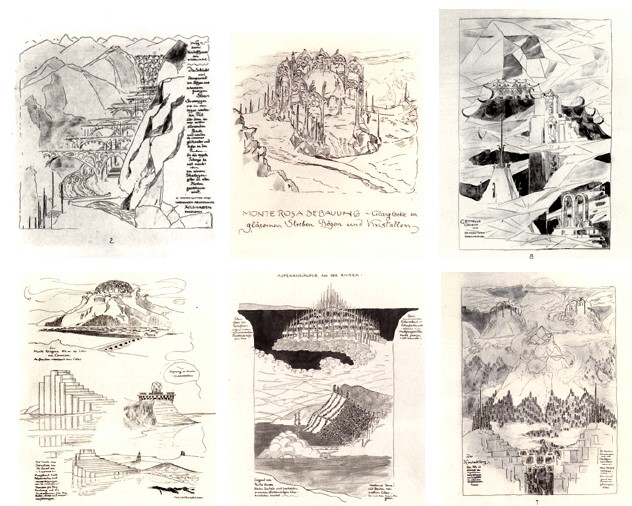
1000ya.isis.ne.jp
นิยามของพื้นที่ในชีวิตประจำวัน
แม้ว่าโลหะเป็นสิ่งที่อยู่ในพื้นที่พักอาศัยของเรามาเนิ่นนานแล้ว องค์ประกอบหลักแห่งบ้านมักถูกครอบครองด้วยวัสดุที่มีคุณสมบัติในการสร้างความรู้สึกอบอุ่น หนักแน่น การท้าทายนิยามเดิมๆของบ้านด้วยการทดลองผ่านงานสถาปัตยกรรมโลหะมีให้พบเห็นได้หลากหลาย ใน Maison de Verre ที่ Bernard Bijvoet & Pierre Chareau เป็นการทดลองนำแก้วและโลหะเข้ามาใช้อย่างเต็มที่ ทั้งในเชิงการอยู่ร่วมกันระหว่างสถาปัตยกรรมเก่าและใหม่ ในเชิงการจัดการพื้นที่ และในเชิงโครงสร้าง มีการทดลองความหมายของการแทรกความเป็นคราฟต์ในเชิงกลไกและความเป็นเครื่องกลในตัวงานสถาปัตยกรรม
นอกจากนี้ ยังมีการทดลองเชิง Modular ในการก่อรูปแบบต่างๆ ซึ่งปรากฏต่อเนื่องมาตลอดตั้งแต่ยุคสมัยใหม่ ในงาน Eames House ของ Charles and Ray Eames และในปัจจุบัน ที่จะพบรูปแบบการทดลองได้ง่ายและชัดเจน ก็คือผลงาน House NAของ Sou Fujimoto ส่วนในรูปแบบของโครงสร้างและพื้นผิววัสดุ Toyo Ito มีการทดลองสร้างบ้านที่เห็นสัจจะวัสดุของโลหะ โดยมีอลูมิเนียมเป็นพื้นผิวทดลอง ซึ่งมีการทดลองออกแบบหลายชิ้นงานหลายรูปแบบและหลายขนาดต่อเนื่องมาโดยตลอด

Photo Credit: Thanatcha Tangsakulruanglai
หลากหลายนิยามของสภาวะ กึ่งภายในกึ่งภายนอก
การปรากฏตัวของสถาปัตยกรรมโลหะ หลายครั้งมักจะตามมาด้วยคำว่าละทิ้ง เมื่อGlass Pavilion ละทิ้งรูปฟอร์มแห่งขนบและสัญญะ อาคาร Sendai Mediatheque โดย Toyo Ito ก็เป็นอีกตัวอย่างของการละทิ้งความหมายแห่งการกั้นพื้นที่ออกเป็นสัดส่วน เกิดเป็นสภาวะกึ่งรวม กึ่งแยก กึ่งข้างใน กึ่งข้างนอก กึ่งห้องสมุด กึ่งพื้นที่ชุมชน กึ่งในตึก กึ่งนอกตึก แม้กระทั่งตัวโครงสร้างเอง ก็ทำหน้าที่กึ่งโครงสร้างกึ่งพื้นที่ใช้งาน สภาวะโปร่งบาง ยืดหยุ่นแต่แข็งแรง มีตัวตนแต่สามารถจางได้จนเกือบไม่มีตัวตนของโลหะ เปิดโอกาสให้สถาปนิกทำการทดลองสร้างพื้นที่ที่สถาปัตยกรรมมีความคลุมเครือ โปร่งบาง และนำไปสู่ความหมายนิยามของพื้นที่กึ่งภายในภายนอกแบบต่างๆที่หลากหลาย
นิยามสู่ความเบาบางไร้ตัวตน
ภายใต้ยุคที่ประชาชนมีความเท่าเทียมกัน เมื่อเราเริ่มให้ความสำคัญกับการอยู่ร่วมกันในสังคม ด้วยการเปิดพื้นที่ว่างให้เข้าถึงง่าย เกิดการรับรู้ซึ่งกันและกัน การมีสถาปัตยกรรมที่ไม่ปิดกั้นทางเดินและการมองเห็นในเมือง และอยู่ร่วมกับบริบทพื้นที่ การให้คุณค่าในสัดส่วนของมนุษย์ รวมไปถึงการให้คุณค่ากับสิ่งแวดล้อมทั้งที่มีชีวิตและไม่มีชีวิต ทั้งที่มองเห็นและไม่เห็น ทั้งที่ปฎิสัมพันธ์โดยตรงและโดยอ้อม ส่งผลต่อการรับรู้พื้นที่เข้ามาในรูปแบบของสภาวะที่มองเห็น และมองไม่เห็น การสร้างพื้นที่จึงอาจเกิดจากบางสิ่งที่เอื้อให้รับรู้ได้ถึงอาณาบริเวณหรือสภาวะที่เอื้อให้ทำกิจกรรมได้ (affordance) โดยอาจไม่จำเป็นต้องปิดล้อม แต่เกิดจากบางสิ่งบางอย่างที่ตั้งอยู่ อย่างที่รู้สึกได้ในงาน Vieux Port Pavilion โดย Foster & Partners ตั้งอยู่ในเมือง Marseille หรือ Naoshima Ferry Terminal โดย SANAA หรืองานของ Ishigami Junya ต่างแสดงออกถึงสถาปัตยกรรมโลหะที่กลายสภาพเป็นเหมือนวัตถุชนิดหนึ่งที่อิงอยู่ในบริบท ใช้ตัวตนของมันสร้างสภาวะบางอย่างที่เอื้อให้เกิดการรับรู้ในมิติต่างๆ อาจจะเป็นการรับรู้อาณาบริเวณจากบางจุดบางมุม อาจเป็นการรับรู้การเคลื่อนไหวของอีกฝั่ง อาจเป็นการรับรู้พื้นจากภาพสะท้อนโลหะเบื้องบนผ่านการมองขึ้นฟ้า อาจเป็นการรับรู้ตำแหน่งที่ล้อมด้วยกลุ่มเสา สถาปัตยกรรมโลหะจึงแสดงตัวตนอย่างเบาบางที่สุดในสถาปัตยกรรม หรือแม้แต่บางครั้งก็อาจมีอยู่แค่เป็นชิ้นส่วนที่น้อยชิ้นที่สุด จนแทบจะเป็นแค่องค์ประกอบหนึ่งในบริบทพื้นที่เท่านั้นอย่างที่ Nendo พยายามสร้างสภาวะ พื้นที่จากการกำหนดพิกัดที่เอื้อให้เกิดกิจกรรมขนาดเล็กโดยองค์ประกอบที่มีสัญญะของการใช้งานอย่างโต๊ะ Cloud Coffee Tables Moroso

Photo Credit: Thanatcha Tangsakulruanglai
จะเห็นได้ว่าการปรากฏขึ้นของสถาปัตยกรรม สะท้อนถึงสิ่งที่มนุษย์สนใจมาอย่างยาวนาน ทั้งการก้าวข้ามความท้าทายในโครงสร้าง ความพยายามเผยความงามแห่งสัจจะแห่งกลศาสตร์ นำไปสู่ความหมายการตีความเชิงชนชั้นและมวลชนในสังคม อยู่ในวิถีการต่อสู้แห่งคราฟต์และอุตสาหกรรม เป็นเครื่องมือในการประชันกันเชิงนวัตกรรมทั้งในช่วงสงครามและในช่วงสันติภาพ เป็นศักยภาพที่ดีในการสร้างฝันสู่อนาคต เป็นวัตถุที่เข้าถึงง่ายในการสร้างที่อยู่อาศัย เป็นสิ่งที่มีศักยภาพมากในเชิงการรับรู้ เพื่อสร้างสภาวะศิลป์ และเป็นได้แม้กระทั่งการมีอยู่ที่น้อยนิด หรือการมีอยู่ที่สะท้อนสภาวะแวดล้อม ราวกับสถาปัตยกรรมนั้นไร้ซึ่งตัวตน สถาปัตยกรรมคืออนาคตที่กำหนดสร้าง และก็คือปลายน้ำแห่งวัฒนธรรม การเกิดขึ้นของสถาปัตยกรรม คือปรากฎการณ์ทางความคิด และปรากฎการณ์ทางความคิดที่โลดแล่นผ่านกาลเวลาอันยาวนานนั้น ก็มีสถาปัตยกรรมโลหะ เป็นหนึ่งในตัวละคร ที่เล่าเรื่องจุดเปลี่ยนทางความคิดที่เกิดขึ้นในแต่ละยุคสมัยได้เป็นอย่างดี

Photo Credit: Yoshihiro Fukai
หากมนุษย์คือสัตว์ชนิดหนึ่งที่อาศัยอยู่ในเปลือกโลก ขุดวัตถุจากโลก มาแปรรูป ก่อฟอร์ม สร้างสถาปัตยกรรมและวัตถุรองรับการใช้ชีวิต เพื่อใช้ชีวิต อยู่บริเวณผิวโลก อันครอบคลุมไปถึงส่วนใต้ดินและบนดิน เช่นเดียวกับสัตว์ชนิดอื่น สถาปัตยกรรมโลหะก็คือหนึ่งในวัตถุแห่งเปลือกโลก ที่เราแปรรูป ก่อร่างขึ้นมา เพื่อตอบโจทย์ความหมาย ทั้งในเชิงสถานะวัตถุทางกายภาพ รองรับการปรับสภาพและควบคุมพลังงาน เป็นทั้งเครื่องกลแห่งวิถีชีวิต และสาส์นแห่งการสื่อสาร เมื่อเราสร้างสมดุลความหมายของสสารแห่งเปลือกโลก ให้ตอบโจทย์การรับรู้ในสมองของเรา ด้วยสัดส่วนต่างๆตามวาระเวลาและค่านิยมของสังคม การเล่นกลกับสสารของเราเองบางครั้งก็สร้างแรงกระตุ้นกับการรับรู้ในสังคม เกิดแรงกระทบให้มีการวิวัฒนาการทางความคิดในรูปแบบต่างๆต่อเนื่องกันไป หากสถาปนิกคือนักมายากลที่เล่นกลกับสสารแห่งเปลือกโลก เพื่อให้เกิดแรงตระหนักและการส่งต่อซึ่งวัฒนธรรมแล้ว ไม่ว่าจะเป็นในรูปสถาปัตยกรรมโลหะหรือสถาปัตยกรรมชนิดอื่น เราทุกคนต่างกำลังทำหน้าที่แปลงสสารของเปลือกโลกทุกขณะเวลาและส่งสาส์นแห่งความขับเคลื่อนทางนวัตกรรมของสถาปัตยกรรม ในทุกขณะของการทำงานของพวกเราด้วยเช่นกัน

smarthistory.org
According to Karl Marx, human beings create their own history and narrative, but those unintentional happenings are entangled with a plethora of past and present circumstances and conditions. Even lost cultures continue to transfer beliefs and ideas into the world and people of today, acting as a cultural mechanism that continues to birth new things.
Concrete, metal, and glass are cultural byproducts of modern architecture as a creature that modifies practically every object on the earth’s surface. Metal architecture is a form of inherited culture. Through experimentation on metal architecture in various eras, we have seen observable transitions between differing definitions of architectural ideology.
Metal Values Based on Truth-to-Material Tenet
The development of metal architecture inside the realm of the ruling elite, such as the Royal Pavilion in Brighton, designed by John Nash between 1815 and 1823, was one of the historical milestones where metal was embraced in architecture for its truth-to-material characteristics. The work displays the true nature of the material through its structural integrity, exterior surface, and interior spaces. It communicates the promise of steel through slender columns and a free-form framework borrowed from traditional architectural language. The maniera technique was utilized to replicate the form influenced by Indian architecture. Steel was then introduced as a replacement for the original material. What ensued was a symbol of colonial architecture in which the past and new construction techniques met perfectly.
Scientific and Artistic Experiments
According to Sigfried Giedion, architecture was originally a combination of art and innovation. As a result of the modern world’s proliferation of specialized fields and specialties, architecture has diverged into different schools, each with its own evolution. Instead of having a coherent body of knowledge, they frequently clash and contradict one another. In today’s society, architecture is expanding into numerous fields. A clear distinction emerged when École des Beaux-Arts, founded in 1648, and École Polytechnique, created in 1794, were directed in different directions concerning architectural education. Despite the apparent separation of the two disciplines, one person’s endeavor to merge the two fields made a substantial impact.
Henri Labrouste (1801-75), an art student at the École des Beaux-Arts, had long been curious about the meaning of art, even as he pursued a rigorous study of innovations. Bibliothèque Sainte-Geneviève (1843-50) and Bibliothèque Nationale de France (1858-68) were experimental structural designs created by Labrouste as someone with an artistic and architectural background.
Henri Labrouste’s works from the 19th century exhibited an Eclecticism approach. They depict the story of a point of convergence between transitions, debates, and reconciliation between art and innovation, old and new, rooted development and forward movement, compromise and conclusive. Physical status divides a shelter for reconditioning and energy regulation, a status of a living mechanism, and a communicative object. Although in the same building, everything was scattered to separate regions and had different meanings.


(top) networkrail.co.uk
(below) Photo Credit: Yospunya Pensuwan
The Mechanism of a New Way of Life
Metal architecture has evolved continuously since the 19th century and serves its political role. It was used to demonstrate competitiveness in innovation and to express social class issues. The emergence of the Industrial Revolution and technological advancements resulted in increased urbanization. As a result, new ways of life advanced in public utility, vocations, and human behaviors emerged. New structures were built to accommodate these new lifestyles. Train stations, markets, warehouses, shopping malls, exhibition halls, glasshouses, and arcades were growing rapidly, with an innovative connotation linked to them. This resulted in a multitude of metal architecture experiments based on structural possibilities and functional programming. Structural innovation and spatial innovation schools collaborated to divide functions into proportions. Conceptual designers were involved in initiatives that were critical to the image and vision of a city. The Paddington Train Station, created by engineer Isambard Kingdom Brunel and architect/historian Matthew Digby Wyatt, is an example of a collaborative effort involving architects from different disciplines.
A New Spatial Enclosure
Crystal Palace is the official debut of metal architecture. The edifice was designed for the first World Expo in London (1851) by an English gardener and glass house specialist, Joseph Paxton, as opposed to an engineer or architect. It was the height of Britain’s colonization age when plants were collected from all over the world, and the country saw widespread construction of glasshouses. The Crystal Palace design competition was among the phenomenon. Paxton’s design was chosen over those of other architects because it had an area for indoor-growing plants that were designed to match physically with the building’s architectural form and structure. The design introduced a new spatial perspective, moving away from the symbols of the past and toward a more functionally and structurally driven shape. It generated an enclosed space that has no sense of enclosure, forcing architects to come up with their definitions of this new physical environment, such as “a space that isn’t empty,” “a glass-encased air,” or “airflow amid a thin frame.” The phenomenon impacted the concepts and advances that went into the subsequent designs of open spaces.
Furthermore, another notable aspect of Paxton’s design competition victory is the management of structure and craftsmanship techniques. Because of their reduced weight, modular and prefabrication methods were used for the project’s grand scale. To handle a production of such magnitude, the required time and components needed were meticulously estimated. It simplified the logistics and construction of such a big building, allowing it to be completed in six months. In a society where labor-saving devices like cranes were non-existent, a building designed to have a specific maintenance system and calculated life cycle from installation to demolition transformed Crystal Palace into a comprehensive work of architecture. Later it influenced the birth of several other metal structures in urban developments worldwide. Crystal Palace is regarded as a symbol of the full-fledged arrival of the metal era in architecture.

archdaily.com
Technological Advancement in High-rise Buildings
There was a gradual shift away from the image of a solid, monolithic building and toward something lighter and more open, with references to inherited cultures and customs, and finally to magnificent works of architecture with practical virtues and structural integrity. Then it progressed to the construction of architecture through forms, structures constructed from modular systems, architecture encased in symbolic shells, and finally, the type of architecture stripped of everything and told its own stories and essences. This increasing public perspective of architecture became a factor in the birth of another notable architectural building, the Eiffel Tower, designed by Alexandre Gustave Eiffel for the World Expo held in Paris, France. The work is regarded as another masterpiece of metal architecture. To construct small metal parts that were interlinked into the tower’s architectural mechanism, advanced calculations were carried out. Hinges and arches were used after the weight transfer and wind pressure calculation. Along with the creation of the Eiffel Tower, new elevator innovations were born. The calculation techniques employed in the design and construction of the Eiffel Tower were later developed for the design of many other high-rise buildings.

en.wikipedia.org
Craft and Industrialization
In terms of material management, the modern era was characterized by a conflict between the humanistic values of craft and industrial management. Metal has become a primary material used as a design tool to communicate and debate the meanings of handcrafted creations, which connoted human labor and life (artisans), industrial production, and the rapid production capacity it could deliver. It also connoted the opportunity it provided the public access to materials with greater properties and potential. Both sides were eventually included as the polarities of modern architectural discourse, whether a man-made invention or the result of mass industrial production. Bruno Taut did works demonstrating an enormous endeavor to integrate art, craft, and accessibility by the mass of metal architecture in a contradictory and disputed setting.
Tools of Ideological Battle Through Architectural Messages
The meanings of metal building fluctuated between being the result of artistic and artisanal expertise, technological advancement, and experimental connotations. Metal architecture had been used extensively to convey a message which became most apparent during the First World War. The urge to select sides led to numerous competitions for cultural growth and creativity, including architecture. Architects from both political ideologies designed multiple instances of experimental architecture. The sketches of Vladimir Tatlin (1920) and El Lissitzky were the most prominent manifestations of the Russian Avant-garde doctrine. Despite the concepts not being implemented during wartime, it was clear that metal architecture was a crucial instrument for architects to experiment with various architectural possibilities, from structural to functional meanings, the development of spaces, and symbolic implications.
Sketch of the monument to the Third International by Vladimir Tatlin 1920
paradjanov.biz
(right) Lenin tribute by El Lissitzky 1920
artpedia.asia
Dreams for the Future
When an architectural work is created, a new mechanism of life is initiated. Therefore, architectural design is akin to designing the future, be it the future of the next few seconds or the future that will impact cultures and people’s way of life. Experimental design in future studies has been utilized for this reason. Sometimes designing the future takes the form of theories, and sometimes it takes the form of movements such as Metabolism. Occasionally, events, such as the World Expo or the Olympics, evolved as a strategy during wartime. The spaces designed particularly for experimentation, such as the Serpentine Pavilion or Triennale, demonstrate the structural flexibility that metal architecture has afforded and enabled new conceivable experiments and creative interpretations of assembled components that bore unprecedented spaces.

Miyajiro town hall kikutake kiyonori 1966
Photo Credit: Duangkamol Pornpattanalertkul
Everyday-life Spaces
While metal has long been a feature of human living spaces, the fundamental components of a house are usually elements that convey warmth, security, and comfort. Countless metal architecture designs challenge conventional definitions of residential design. Bernard Bijvoet and Pierre Chareau experimented with the bold use of glass and metal with Maison de Verre to manifest the coexistence of old and new architecture and spatial and structural management. The work explored the significance of craft as a mechanism and the mechanical characteristics of the building itself.
Other modular experimentation on the many formations of forms occurred throughout the modern age in works such as Charles and Ray Eames’ Eames House. House NA by Sou Fujimoto illustrates a simple and straightforward experiment in a more contemporary period. In contrast, Toyo Ito’s structural formation and material finishes reveal an experimental residential design that showcases metal’s truth-to-material attributes with aluminum used as an experimental surface. Experiments were carried out on works of various genres and scales.
Multiple Definitions of the In-between Stage of Indoor and Outdoor
When glass pavilions deviate from standard forms and symbols, the birth of metal architecture is frequently accompanied by the term departure. Toyo Ito’s Sendai Mediatheque is another intriguing example of a design that departs from established conceptions of how spaces are split. The design creates an in-between stage of unification and division, outside and inside, an ambiguity between a library and a public space, indoors and outdoors. The architecture works as both the structure and the functional area with its open, airy, and flexible properties that are also strong. The metal’s identity is there, but it’s barely there. The design allows the architect to explore, producing architectural space that is ambiguous, open, and flexible and providing multiple definitions and interpretations of a semi-outdoor/semi-indoor area.
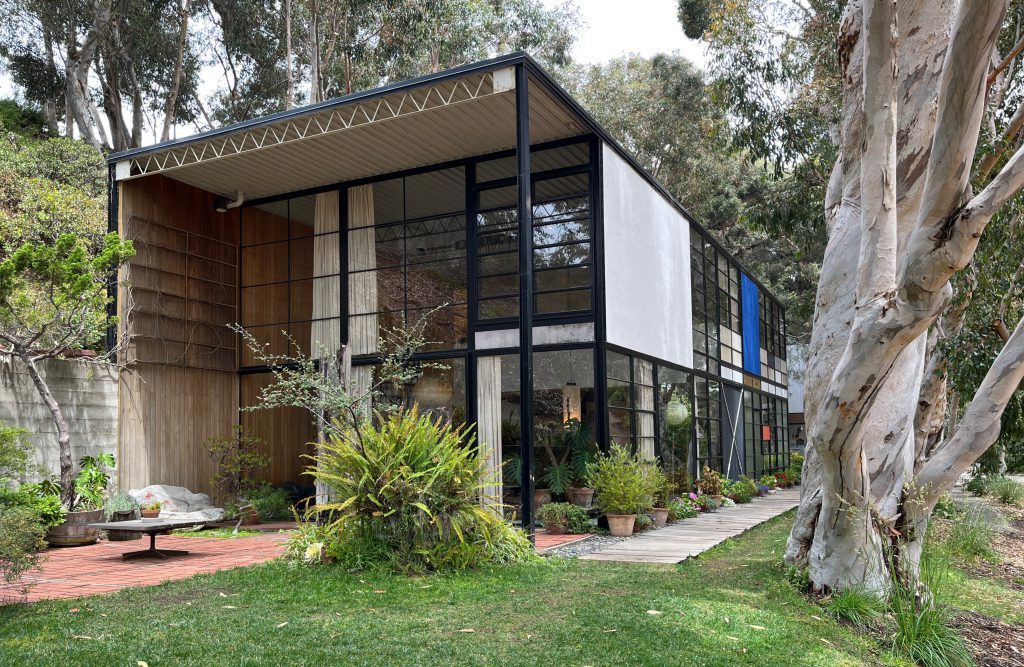
The Eames House by Charles and Ray Eames 1949
Photo Credit: Mamiko Miyahara
An Unknown and Unbearable Stage
When the members of the public recognize and value each other’s equality and civilized coexistence, spaces become more open and accessible. Having architectural features that do not hinder city walkways and visual access to urban spaces, values human scale and biotic and physical environment, both visible and invisible, directly and indirectly, alter the way one views space as both visible and unknown stage. A creation of space may result from an affordance that allows one to experience a space or engage in an activity without the necessity for an enclosure rather than from anything with discernible existence. The Vieux Port Pavilion in Marseille by Foster + Partners, the Naoshima Ferry Terminal by SANAA, and other works by Junya Ishigami are all examples of metal architecture and its transformation into contextually derived objects. The identities of these works establish a condition that allows for different perceivable dimensions, whether an experience of certain parts or corners or movements occurring on the opposite side. It can be an experience of the reflected image on the metallic surface as one stares up at the sky, or it can be a perception of a place surrounded by a swarm of columns. As a result, metal architecture exposes itself in the most delicate way within the creation of architecture. It sometimes exists in the fewest number of components, reduced to merely an element existing as part of the surrounding context. It is similar to how Nendo strives to establish a stage where space exists through the calculated placement of Cloud Coffee Table Moroso in an arrangement that allows small-scale activities.
The emergence of architecture reflects several of humanity’s long interests, ranging from attempting to overcome structural challenges to revealing mechanisms’ empirical and true beauty, all of which lead to interpreted definitions derived from societal classes and the people in a society. Architecture is an ingenious device for opponents to fight with in war and peace. It stands in the battleground between crafts and industrialism. It has a high potential for imagining and realizing future ambitions and is a simple object for constructing living spaces. It can be perceivable to provide an artistic experience and a humble existence while reflecting on the surroundings. It was as though architecture were imperceptible. It is the predestined future and the cultural downstream. The birth of architecture is an ideological process. One of the characters in this phenomenon that travels through time is metal architecture, which precisely chronicles different changes and transitions in different periods of history.

Photo Credit: Siriporn Dansakun
Human beings inhabit the earth’s surface, mining objects, and resources, transforming them into forms, and constructing architectural structures and objects to accommodate their ways of life. Humans live and thrive on the earth’s surface, below and above ground. Like other living beings, metal architecture is an object on the earth’s surface due to humans’ efforts to alter and build something to attain specific goals and fulfill particular meanings. It is a physical thing that can be modified and whose energy may be controlled. It is a mechanism of human life and a medium of communication. When we create equilibrium for the meaning of this substance on the earth’s surface, we make it respond to how our brain perceives things, whether in amounts, determined by time, or societal values. By playing tricks on the substance we create, we can occasionally stimulate new societal perspectives, and waves of ideological evolution take place in varied, ongoing forms. Architects are like magicians who transform or produce something through a seemingly magical process that plays with various substances in this world. Cultural realization and transmission have occurred due to it. Whether in metal architecture or architecture of any kind, we are all transforming every substance in the world, sending out messages that drive forward architectural innovations at every passing moment of our plight and practice.

Photo Credit: Aroon Puritat
อ่านบทความคอลัมน์อื่นๆ หรือดาวน์โหลดเล่มวารสารฉบับออนไลน์ 09 Metal Attraction คลิกได้ที่นี่




